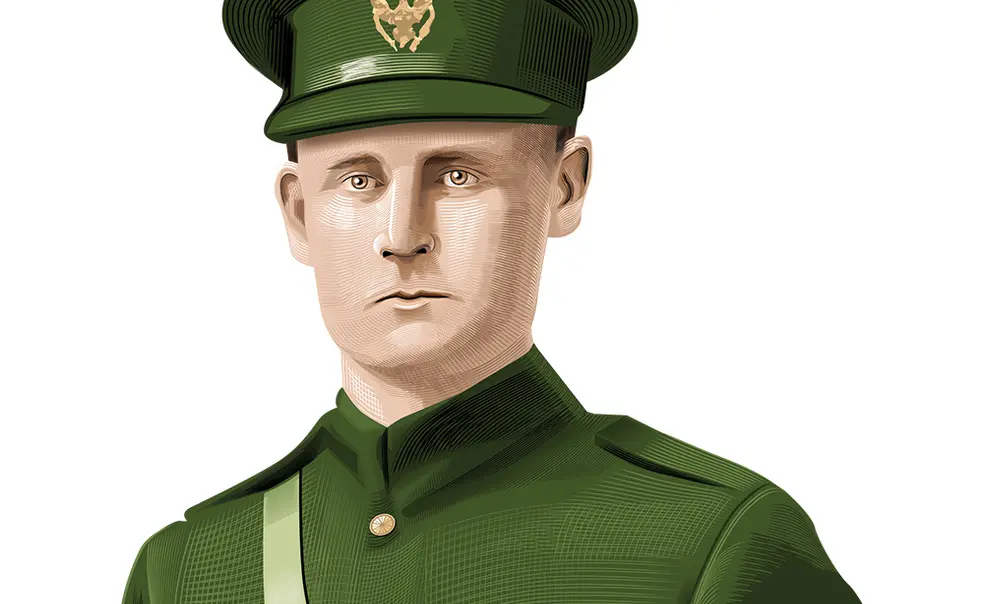A Flyboy’s World War I-Era Journal Finds Its Way Home
William Hamlin Neely 1917 (1896-1962)
When William Neely 1917 was in his senior year, he joined the Princeton Flying School. World War I was raging in Europe, and though the United States hadn’t yet entered the war, any observer could see that it would do so soon. (The U.S. entered the war in April 1917.) And so, Princeton University, to prepare its students for the fight, set up an aviation training school — eight weeks of study in flight mechanics and aerial combat tactics. The students took classes in Patton Hall; the faculty, having trained at a flight camp in Toronto, served as instructors, as did pilots who taught the actual flying. An anonymous alum donated two airplanes — Curtiss JN-4 models, nicknamed “Jennies.”
Flying in those days was an open-air adventure. The pilot sat in an exposed cockpit wearing goggles, a leather helmet, and a scarf to protect his neck from the cold. A technician had to spin the propeller to get the engine going. Once the plane had slipped the surly bonds of Earth, the pilot could see the town and campus as nobody had ever seen them before. (The planes took off from a landing field that had been prepared on a farm a few miles away from town.) After the day’s training, as a pilot’s wife (and later aviator) who knew them, Edith Culver, wrote in a memoir, the flyboys — still wearing their aviation overalls, which they jovially referred to as “drinking suits” — drank beers together at the Nassau Inn and sang college songs.
Neely, the son of an old Pennsylvanian family, kept a journal while he was in college: a handy little black leather affair in which he diligently wrote his daily reflections. On his birthday in February 1917, he wrote, “Today I have become [21] years old. I am now a man. It is up to me to do a man’s work. I don’t feel as though I have developed as much as I should at this age. I have not got as much self confidence in myself as I should have.” At flying school, he found the confidence that had eluded him on the ground. By May, he was writing with gusto about his training flights: “Piloting the plane. The danger is the last thing that enters one’s head.”
After his wartime adventures — which included a sky battle against the Red Baron’s “Flying Circus” — Neely went home to Pennsylvania to study law. He rose to the highest judicial position in the Commonwealth Court of Pennsylvania while raising the fourth generation in a veritable Brady Bunch of Princetonians. (His sons, Jim Neely ’48 and William “Ham” Neely ’47, attended Princeton, as did his brother, father, uncle, great-uncle, and grandson, Robert Neely ’03.)
Parents give their children all they can, but one thing they can’t give them is the experience of knowing them as they were before the children were born. Sometimes, though, the universe offers that gift. In 2023, Jim and his wife, Patti, were doing an internet search to remind them of the date of William’s death, and they found an article that mentioned William’s college journal. They’d had no idea it existed.
Robert contacted the people who wrote the article. It turned out that William’s wife kept the journal until her death in 1984, after which it went to Jim’s older brother, Ham. Ham loaned it to a World War I historian, Mike O’Neal, then died before he could get it back. O’Neal showed it to the article’s authors.
Robert kept his sleuthing secret from his father, which allowed him and his family to give his father the present of a lifetime. Shortly before Christmas, they received in the mail a candy box that bore a sketch of a WWI plane on top. O’Neal had sent the journal home.
“I held the journal until Christmas morning,” Patti writes. “Then, with two sons here with us and Robert on Zoom, Jim opened the peppermint candy box and found the journal. It was awe-inspiring for him to hold a 105-year-old book written in his dad’s hand and to read about his flying.”












No responses yet